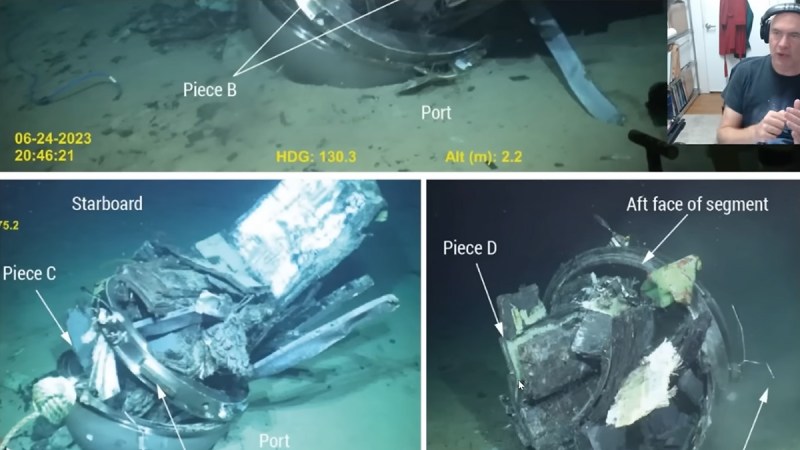When the files on the Titan submersible disaster were published, most people skimmed for drama. Hackers, however, would likely zoom in on the hardware autopsy. [Scott Manley] actually did this. He faced a hacker’s nightmare: three crushed PCs, bent SSDs, and an encrypted SD card from a camera that survived six kilometres under pressure, all sealed in titanium and silence.
[Scott] went all in to resurrect data. First came CT scans: firing 320 kV X-rays through a kilo of mangled electronics to hunt for intact NAND chips. When that failed, he desoldered UFS memory by hand, used custom flash readers, cloned NV-RAMs, and even rebuilt boards to boot salvaged firmware. The ultimate test was grafting the recovered chips onto donor hardware in Canada. Like the monster of Frankenstein, the system came to life.
In the end, it partially worked. Twelve stills and nine videos were retrieved, albeit none from the fatal dive. The process itself was a masterclass in deep hardware forensics, here covered in a video worth watching.
















yeahumm… I don’t think [Scott] did any of the things mentioned. He ran through and presented the reports of the analysis done by other people.
This. What an amazingly glaring oversight.
This is proof that most YouTube links masquerading as ‘articles’ here on HaD are worthless. They clearly don’t even bother to watch the videos. That’s why most are just 3d printing garbage to feed the algorithm.
In this case, Scott’s video is a great breakdown of the process the investigators went through.
I do worry a little about Scott’s channel though. He recently left Apple to do YouTube full time, and the other ‘mentors’ he has been getting advice from are the exact kind of ‘content creators’ that are YouTube’s problem. They are the kind of people who make videos for the sake of having a video out this week, rather than because they have something worth showing. It’s becoming about the algorithm and SEO, instead of the subject matter.
Is this AI slop? WTF, Manley didn’t do anything of the sort, he just made a video about the NTSB’s investigation.
WTF is this article?
So to conclude there is a new AI staffer at HaD, they named it “Heidi Ulrich”
Oh and is that asheets comment AI too? Is it April again?
30 some years ago, someone pointed out that ‘AI’ was super ambitious.
‘AS’ (artificial stupidity) was a more realistic goal.
I’m ready to call that achieved.
Sure the stupidity is statistical repetition of training stupids.
Just like wet stupids do.
I watched this video a month (or two?) ago, and there is nothing new in it for me. I don’t care about the mangled pieces. The most interested part starts at around 27:00 and it mentions the strain gauge data of the dives and the shift in their data at around dive 80. That is where “something broke” in the hull (and with a loud bang too) but it was dismissed, as you’d expect from a boss that cuts corners. The total collapse would be pretty inevitable after that. Petty clear in hindsight.
And the most obvious design flaw is of course that fibers can be pretty strong in tension, but they do not do much in compression. And even if you glue them together, under compression it’s still the glue taking the forces instead of the fibers.
I forgot whether this video also mentions the work attitude of the guy, and that he just fired people who mentioned the inherent unsafety of the whole design. Scott Manley talked quite a lot about this in a video half a year (or more) ago.
And hackaday’s article written like Scott figured this all out by himself (instead of nicely presenting research done by others) is quite silly and unfortunate.
SciFun made 3 videos (1 hour each) about Titan. Very good in depth analysis and author still had to skip some facts. There were so many failures on so many levels that using fibers becomes less obvious since they grind the structure to make surface even.
Reeealy should edit this post to point out Manley is just reviewing the investigative work the government did.
“The ultimate test was grafting the recovered chips onto donor hardware in Canada”
Damn Canada, thats the ultimate test indeed
erm …
What a bunch of lies
Yeah first sentence ok he is zooming in on the evidence
”[Scott] went all in to resurrect data. First came CT scans: firing 320 kV X-rays through a kilo of mangled electronics to hunt for intact NAND chips. When that failed, he desoldered UFS memory by hand, used custom flash readers, cloned NV-RAMs, and even rebuilt boards to boot salvaged firmware. The ultimate test was grafting the recovered chips onto donor hardware in Canada. Like the monster of Frankenstein, the system came to life.”
then you go and just make it blatant